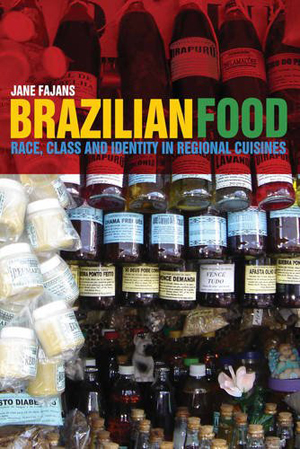Fajans examines food, comfort, connection in Brazil
By Kathy Hovis

Professor of anthropology Jane Fajans has been known to cook up a mean pot of feijoada, but most of the other dishes she enjoys while visiting and studying in Brazil are hard to re-create. The ingredients just aren’t available here.
Fajans’ newest book, “Brazilian Food: Race, Class and Identity in Regional Cuisines” (Bloomsbury, 2012), explores regional differences in the role of food in Brazilian culture and family life, as well as the ways Brazilian cuisine has attracted tourists and become popular throughout the world.
From feijoada (a traditional dish of beans and meat) to moqueca (seafood stew), Fajans worked her way around most of Brazil, talking to residents and chefs, taking cooking classes and sampling regional favorites at homes, restaurants, markets and even bus stops.
“When people in Brazil speak of food, the first word they use is ‘farta’ – filling or satisfying,” she said. “People use food to find comfort and feel connected to other people. But the ways they do this can vary from place to place.”
Fajans chose to study the role of food in Brazilian culture after many years spent exploring the importance of food among the Baining people of Papua New Guinea during her fieldwork. Her husband, retired Cornell anthropology professor Terry Turner, had studied indigenous people in Brazil for years, so Fajans had spent time in that country and became intrigued with its food and culture.
From early trips to Rio de Janeiro, where she found daily rice and beans tiring, Fajans explored the regions of Espirito Santo, Bahia and Minas Gerais – where she found unique iterations of traditional dishes, as well as regional dishes reflecting the cuisines of the immigrants who settled there.
Brazil’s history of slavery is reflected in many ways in its regional food, Fajans said. Many families who are descended from slaves in the Amazon and Minas Gerais regions include ingredients in their cooking that would have been brought over from Africa or salvaged from the tables of their masters, so Fajans found variants on pork and beans, collard greens and grits in their dishes.
At the same time, the abolition of slavery in 1888 and subsequent new agricultural ventures drew migrants from war-torn and poverty-prone areas in Italy, Germany, Japan, Lebanon and Eastern Europe. These groups added their own important dishes and ingredients to the national diet, Fajans said, ranging from kibe (a fried beef and bulgur wheat dish) to sushi to stroganoff.
Today, gourmands in Brazil can enjoy a 14-course meal rivaling any haute cuisine in top restaurants, while home chefs still rely on traditional rice and beans and feijoada for family meals. But the importance of being full or satisfied is truly first in people’s minds, Fajans said, given Brazil’s history of hunger and food scarcity, a problem now disappearing thanks to a host of new social programs.
Fajans’ next food-related venture will look into the cuisine and culture of the southern regions of Brazil, as well as Portugal.
Kathy Hovis is a writer for the College of Arts and Sciences.
Media Contact
Get Cornell news delivered right to your inbox.
Subscribe